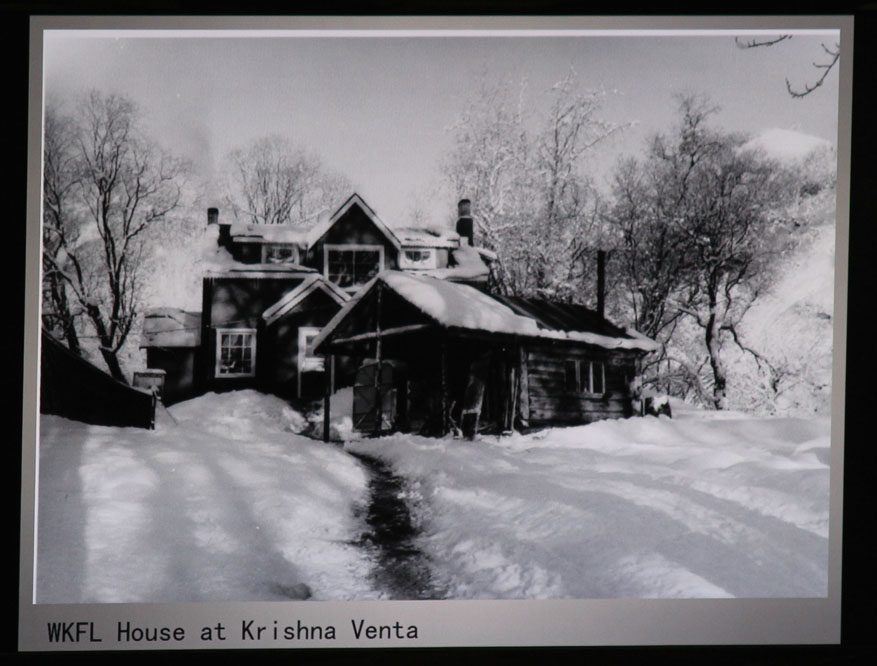While Homer talks about being open for business, expanding the harbor, upgrading streets and all the things that allow a city to meet the needs of its residents, 160 acres to the east, along the Fox River Flats, has been safeguarded since 1997 at the request of its former owner, Thomas Boblick.
The Krishna Venta Conservation Area bears the name of Boblick’s spiritual leader, but protecting the area’s wildlife is what Boblick had in mind.
“In the spring of 1997, he conceded that additional value for educational uses could be compatible with the primary conservation goal, and he approved uses such as ‘student trips of conservation of natural wildlife or natural trails,’” said Marie McCarty, executive director of Kachemak Heritage Land Trust.
The deed for the parcel was transferred from Boblick to KHLT in 1997. Although it is one of the most difficult KHLT areas to access, it is open to the public.
At the annual meeting of KHLT, held at the Pratt Museum Dec. 4, a presentation on the conservation area was given by Mark Marette, owner of Trails and Horse Adventures who leads guided horse trips up the Fox River Flats. It included a slide show of pictures from Helen Jackson, who came to Alaska in 1957.
Jackson was part of the “Fountaineers,” a portion of a larger group from California known as the WKFL (Wisdom, Knowledge, Faith and Love) Fountain of the World. Led by Krishna Venta, the group was known locally as the “Barefooters” for their lack of wearing shoes. They purchased three adjoining homesteads in the flats and established the community of Venta.
“Lots of wildlife,” said Jackson, recalling the brown and black bears, moose, wolf, coyote, river otter, lynx, birds and other animals that make this area their home. “It was a beautiful place.”
Jackson frequently traveled between Homer and the new community. Her nursing skills came in handy, and she delivered five babies at the group’s Homer headquarters. At the head of the bay, she taught school, using mail-order correspondence courses.
“At one point in time, we had five kids old enough to go to school, but before you could get a state-funded school teacher, you had to have a school house. So, we built a school house out there,” said Jackson.
Transportation between Venta and Homer was done by foot or with a big garden tractor on the beach. Electricity came to the village when a generator was purchased. Jackson and her husband, RB, another follower of Krishna Venta, set the poles and put up the lines that delivered power to the school building. There were large gardens, a two-story house and other structures. Its sole business venture was a machine shop located on the corner where the city’s WKFL Park now exists. It was run by Boblick.
In 1958, Krishna Venta and other members of the group were killed in an explosion in California. After his death, the Alaska group disbanded and members moved into town.
“I think the last time I came in was 1960 because I was pregnant,” said Jackson, who now lives in Kachemak City. Her husband died in 2003.
The Barefooters weren’t the first ones to enjoy the untamed area at the head of the bay, however. The Fox River Flats were likely a funnel through which goldminers headed for Hope in 1896, bringing cattle with them, according to information provided by KHLT. A man named Thoroughgood began raising cattle in the area in the early 1900s. That led to the arrival of other cattlemen and the formation of the Fox River Cattlemen’s Association. Since then, the Fox River Flats Critical Habitat Area has been designated and livestock continue to graze there.
In 1996, Boblick began steps to preserve the 160 acres on which Krishna Venta and his followers had lived.
“In the end, KHLT resolved to 1) not sell the property, 2) not use the property for commercial purposes, and 3) not to construct buildings on the property for either commercial or non-commercial purposes,” said McCarty.
Boblick made one concession, that a small structure, a latrine, for example, could be built to satisfy health and concerns if educational uses were pursued.
The property’s size, location, biological and physical features, as well as being adjacent to the Fox River Flats Critical Habitat Area, lends itself to conservation, according to McCarty. It serves as a buffer between future development and the critical habitat area.
“Protecting the property’s habitat values is particularly important, given its location at the mouth of one of the last remaining undeveloped canyons along the Homer bluffs at the head of Kachemak Bay,” said McCarty.
McKibben Jackinsky can be reached at mckibben.jackinsky@homernews.com.
Kachemak Heritage
Land Trust
To date, Kachemak Heritage Land Trust has helped preserve more than 3,000 acres on the Kenai Peninsula. Properties are in three general regions:
• Central Kenai Peninsula
• Anchor River and Stariski Creek
• Southern Kenai Peninsula.
KHLT also has worked in partnership with other organizations to protect an additional 677 acres of conservation lands for public benefit.
It works with landowners to place conservation easements on qualifying property, and acquires conservation land through outright donations and bargain sales.
For more information, visit kachemaklandtrust.org or contact Mandy Bernard, KHLT’s conservation director, 235-5263.


